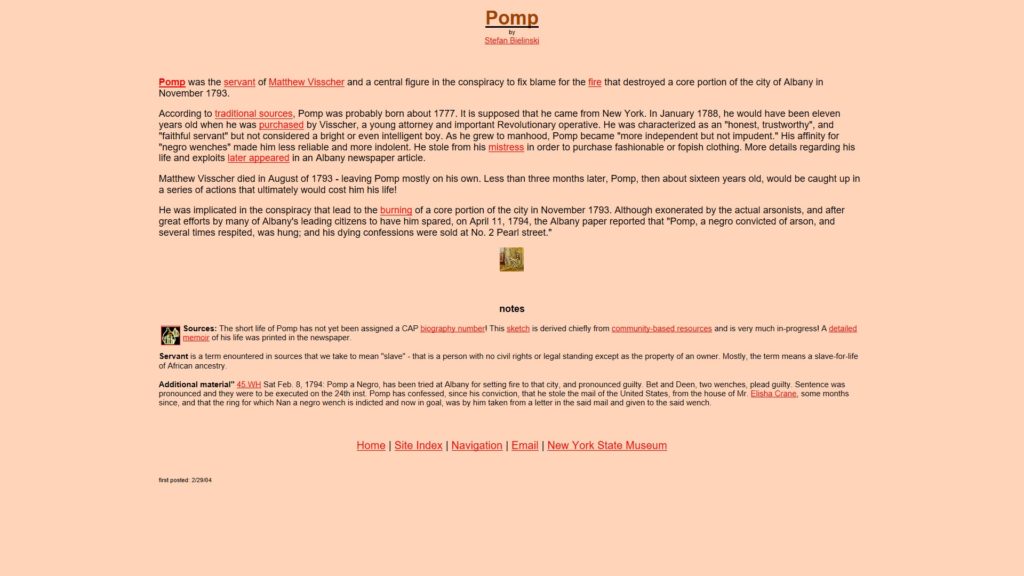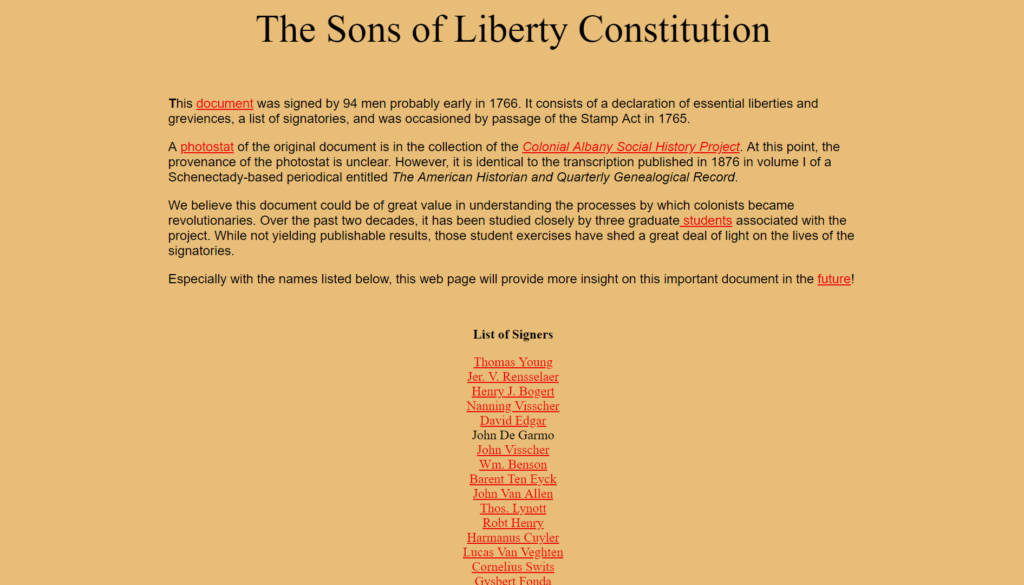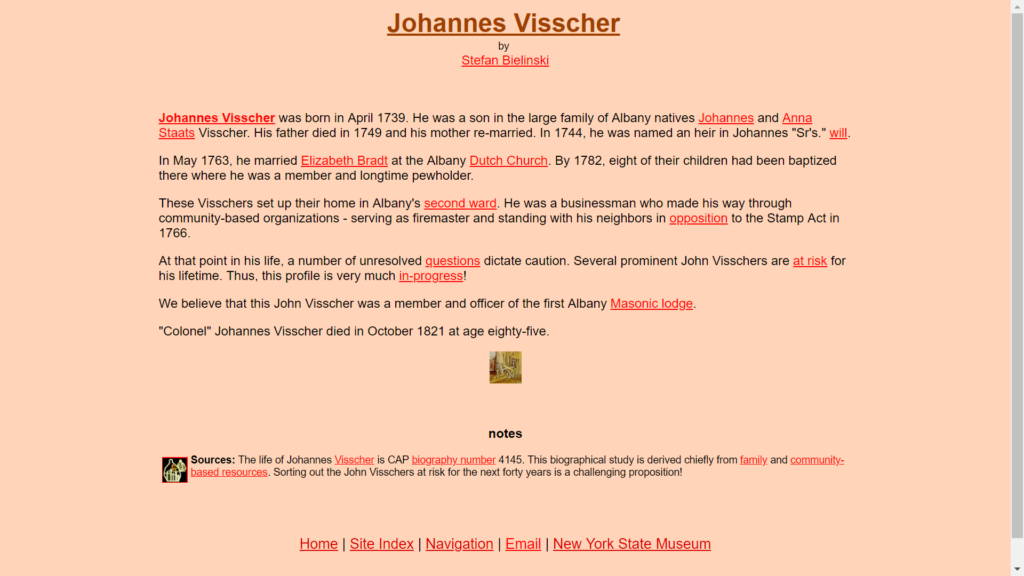Review: The People of Colonial Albany
“The People of Colonial Albany: A Community History Project.” https://exhibitions.nysm.nysed.gov/albany/. Created and maintained by the New York State Museum, Albany, New York, (https://exhibitions.nysm.nysed.gov/albany/whoarewe.html). Reviewed February 1 to February 4, 2019.

The origins of “The People of Colonial Albany” website date back to the early 1980s and the extensive research of the project’s founder Stefan Bielinski, now senior historian emeritus at the New York State Museum in Albany. The project fully embraced the emergence of social history and presents a narrative and extensively hypertextual history of colonial Albany and its people. The website asserts its mission as promoting “human understanding by interpreting the history of the people of a broadly constituted and dynamic community that was the center of a large and emerging region over a two-hundred-year-period.” The introduction to the site guide touts the project as a “model community history program” that seeks to unravel more than “a narrow strand of the overall community mystery.”

The project’s stated goals are: 1) To comprehend a full range of life experiences for all the people who lived in Albany prior to industrialization; 2) To instill an inspiration of their historical experiences broadly across society today; 3) To establish new professional standards for community history research, programming, and community involvement; 4) To provide training and a range of historical services to the people of Albany, New York State, and beyond as a model community history program. The site purports to be an educational resource but is also clearly providing information to a broader audience with an interest in the local history of Albany, New York. For scholars, the site may provide a useful tool for identifying source materials for further study. Historical documents are transcribed on the website by are largely absent in any digital format thereby necessitating efforts to locate the repositories of the collections materials. Unfortunately for the academic historians utilizing the site, source citation and crediting of materials is rather hit-or-miss. The absence of digitized documentary materials on the “People of Colonial Albany” project website is a significant impediment to serious utilization of the site as a research tool.
A visit to the Site Index reveals an organizational structure hardly removed from indexing in a traditional monograph. Subjects are arranged alphabetically with a separate link for an alphabetized listing of the myriad biographies available through the site. The tremendous amounts of historical content accessible through “The People of Colonial Albany” renders it as arguably the most comprehensive source for information currently available for researchers detailing the people of Albany from the wealthy elite, to merchants and farmers, to servants and enslaved persons. The site includes biographies of such noteworthy individuals as Abraham Yates, Jr., a local revolutionary, and Philip Schuyler, a wealthy landowner in Albany who became a major general during the American Revolution, as well as lesser known Albanians as Pomp, an enslaved man convicted of setting the city ablaze in 1793.
Indeed, one should perhaps view “The People of Colonial Albany,” as a book crafted in the digital age rather than a fully functional digital resource for historical research. Bielinski and project staffers make abundant use of hyperlinking to create layers of interconnection amongst the people, places, and events detailed in the historical narrative. The quality and usefulness of the material available through the website varies markedly from topic to topic. A click on the “Sons of Liberty Constitution” link from the Site Index reveals a description of documents in possession of the Colonial Albany Social History Project for two decades alongside promises to provide detailed analysis of the document in the unspecified future. The timestamp on the page indicates it was last altered in 2011, thus one is left to wonder about the reality of any potentially forthcoming information. A disclaimer on the site’s “Who are we?” page notes that the project officially ceased operations upon Bielinski’s retirement in June 2013, though the site indicates that additions and alterations to the content continue to be made. It is thus unclear the actual status of the project or its website.


The site was created using very basic HTML structures. Much of the content was added beginning in the 1990s. It does not appear that any serious effort was undertaken to migrate the site’s content material to more modern or sophisticated platforms. As such, “The People of Colonial Albany” remains minimally interactive for site visitors. The overreliance on hyperlinks with no additional source of navigation leads to a challenging user experience. Explorations into subjects are undertaken through a “hypertextual” journey from link-to-link. Many of these explorations inevitably lead to a dead end with no navigational aids other than to click on the “Site Index” link and begin anew. Navigation to specific pages within the site is done only through external search engines such as Google and requires prior knowledge of what it is one is searching for. Attempting to locate (or relocate) materials can oftentimes prove frustrating. While the goals of the Colonial Albany History Project at the outset were undoubtedly laudable, and the decision to present the vast troves of information in a digital format was likely cutting edge at the time; the failure to maintain technical relevance and modernity ultimately renders the site virtually useless for researchers seeking information on colonial Albany. That the site is buried within the exhibitions module of the larger New York State Museum website also begs one to question the projects efficacy as a tool for even the visitor with casual interest in local history. The incredible amount of information available through the project’s website makes its existence a potentially vital asset for the larger history community. This quantity of material, however, will also undoubtedly require a vast expenditure of resources in order to bring the site back to a functional level. Until that time, though, “The People of Colonial Albany” may be best suited for only the most intrepid of scholars on the topic who recognize and rely on its importance as arguably the single best compilation of materials about colonial Albany and its citizens.